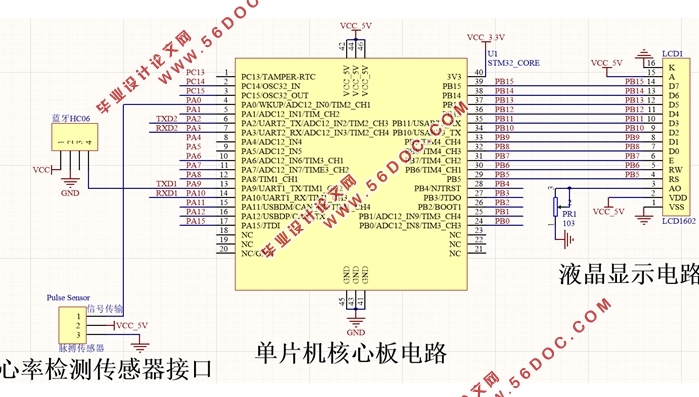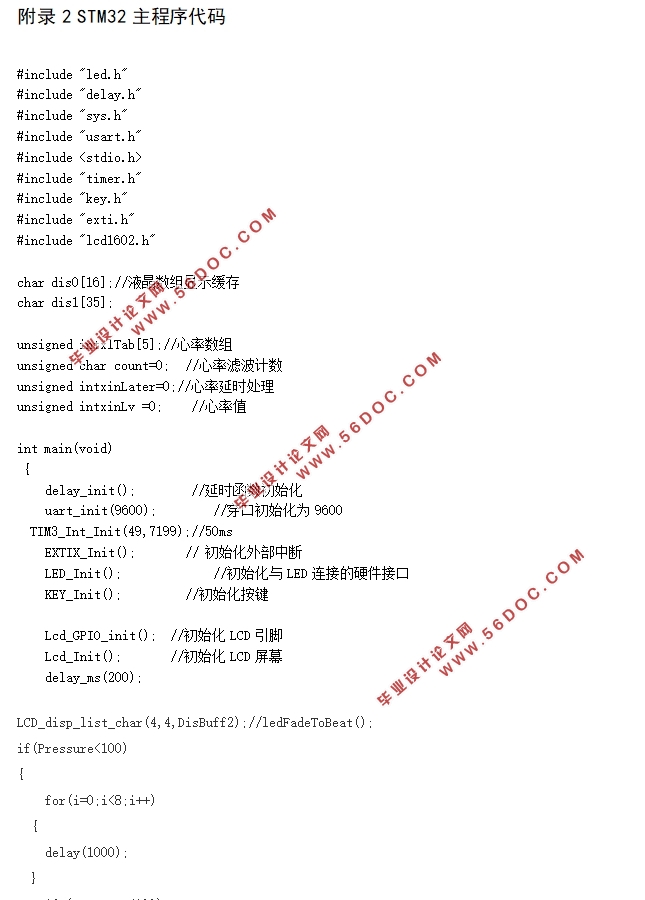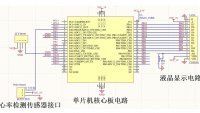基于STM32单片机的脉搏测量仪的设计(附电路图,主程序代码)
来源:56doc.com 资料编号:5D21636 资料等级:★★★★★ %E8%B5%84%E6%96%99%E7%BC%96%E5%8F%B7%EF%BC%9A5D21636
资料以网页介绍的为准,下载后不会有水印.资料仅供学习参考之用. 密 保 惠 帮助
资料介绍
基于STM32单片机的脉搏测量仪的设计(附电路图,主程序代码)(论文16000字)
摘要:脉搏作为反映人体重要生理信息的参数之一,如何快速准确、高效智能的检测成为现代医学不可或缺的一部分。本文介绍了一种基于STM32F103核心板和蓝牙技术的脉搏测量仪。该测量仪采用光电式传感器实现脉搏信号的采集,经过信号处理之后于LCD1602的显示屏上进行数据显示,同时借助易安卓开发平台编译的APP可以轻松实现脉搏信号蓝牙传输和后续数据显示及记录,实现一键式、自动化的脉搏测量。该测量系统相较于传统的脉搏测量更加简单便利,符合日常自我检查的需求,而且成本低廉,数据精确,便于记录。
关键词:蓝牙传输;光电传感器;STM32F103;易安卓
A pulse measuring instrument based on STM32
Abstract:Pulse, as one of the parameters reflecting the important physiological information of human body, has become an indispensable part of modern medicine. This paper introduces a pulse measuring instrument based on STM32F103 core board and Bluetooth technology. The measuring instrument adopts the photoelectric sensor to realize the acquisition of the pulse signal, after the pulse signal processing, the data is displayed on the LCD1602.A mobile APP compiled by the easy for android development platform can easily realize the bluetooth transmission of the pulse signal and the subsequent data display and record, achieve one-button, automated pulse measurement. Compared with the traditional pulse measurement system, this measurement system is more concise and convenient, which meets the needs of daily self-examination. Moreover, it is low-cost, accurate and easy to record.
Key words:bluetoothtransmission;photoelectric sensor;STM32F103;easy for Android


目录
1.绪论 1
1.1脉搏测量研究背景及研究意义 1
1.2脉搏测量的研究现状 1
2.系统基本原理概述与方案设计 2
2.1基本原理 2
2.1.1脉搏信号形成机理 2
2.1.2脉搏信号检测原理 3
2.1.3系统工作原理与流程图 3
2.2主控单片机模块设计方案 4
2.3脉搏信号拾取及处理模块设计方案 5
2.4显示模块设计方案 5
2.5数据传输模块设计方案 5
2.6脉搏测量仪主要技术指标 6
3.硬件系统设计 6
3.1主控单片机系统 6
3.1.1单片机系统 6
3.1.2 STM32系列单片机核心板 7
3.2脉搏信号采集与处理模块 8
3.2屏幕显示模块 11
3.3相关噪声处理 12
3.3.1信号噪声干扰 12
3.3.2工频干扰消除 13
3.3.3基线漂移 13
3.4信号发送与分析模块 13
4.软件系统设计 15
4.1 开发环境搭建 15
4.2 各模块控制程序设计 15
4.3易安卓平台APP开发 16
4.3.1 界面布置 16
4.3.2 添加蓝牙 17
5.系统整体性测试 19
6.结果与数据分析 21
6.1测量结果 21
6.2误差分析 22
7.总结与展望 23
7.1总结 23
7.2展望 23
参考文献 24
致谢 25
附录1 脉搏测量系统整体电路图 26
附录2 STM32主程序代码 26
|





